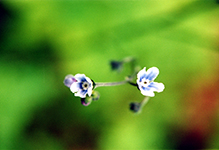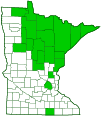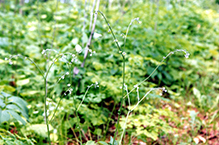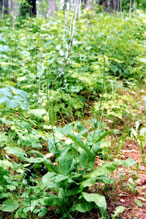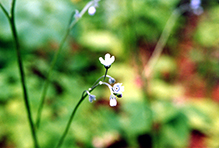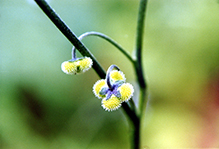northern wild comfrey
(Andersonglossum boreale)
Conservation • Description • Habitat • Ecology • Use • Distribution • Taxonomy
Conservation Status |
|
|||||||
| IUCN Red List | not listed |
|||||||
| NatureServe | N3N4 - Vulnerable to Apparently Secure SNR - Unranked |
|||||||
| Minnesota | not listed |
|||||||
Description |
||
Northern wild comfrey is a 16″ to 32″ tall, erect, perennial forb that rises on a single stem from a taproot. One to six (sometimes more) basal leaves arise from the ground on long leaf stalks forming a rosette. They are 4″ to 8″ long, 1″ to 2¾″ wide, elliptic to oblong, and covered with short, soft hairs. A single, unbranched stem rises from the center of the rosette. It is covered with short hairs and is rough to the touch. There are leaves only on the lower half of the stem. The stem leaves are alternate and untoothed. The leaves are on leaf stalks, which become progressively shorter as they ascend the stem. The upper leaves are attached to the stem without leaf stalks, and may clasp the stem. Most of the leaves are on the lower half of the stem. The leaves become progressively smaller as they ascend the stem. The inflorescence is 1 to 4 (usually 3) elongated, flower stalks (racemes) branching at the end of a stalk that terminates the central stem. The flower stalks are 4″ to 8″ long at maturity, and have no leaves or bracts. The flowers are ¼″ to ⅓″ wide and have 5 light blue petals. The petals are fused at the base into a short, funnel-shaped tube. The tips are oblong and do not overlap. The fruit consists of 4 nutlets, each ⅓″ long, covered with short, barbed prickles. |
||
Height |
||
16″ to 32″ |
||
Flower Color |
||
Light blue |
||
Similar Species |
||
Hound’s tongue (Cynoglossum officinale) has leaves along the entire length of the stem. The inflorescence is many raceme-like, crowded clusters rising from the upper leaf axils. The flowers are maroon or red. |
||
Habitat |
||
Dry to moderate moisture. Fields, meadows, woods openings as well as under full canopy. |
||
Ecology |
||
Flowering |
||
May to June |
||
Pests and Diseases |
||
|
||
Use |
||
|
||
Distribution |
||||
|
Sources |
|||
| 5/1/2023 | ||||
Nativity |
||||
Native |
||||
Occurrence |
||||
|
||||
Taxonomy |
|||
| Kingdom | Plantae (green algae and land plants) | ||
| Subkingdom | Viridiplantae (green plants) | ||
| Infrakingdom | Streptophyta (land plants and green algae) | ||
| Superdivision | Embryophyta (land plants) | ||
| Division | Tracheophyta (vascular plants) | ||
| Subdivision | Spermatophytina (seed plants) | ||
| Class | Magnoliopsida (flowering plants) | ||
| Superorder | Asteranae | ||
Order |
Boraginales (borages) | ||
Family |
Boraginaceae (borage) | ||
| Subfamily | Cynoglossoideae | ||
| Tribe | Cynoglosseae | ||
Genus |
Cynoglossum (hound’s tongues) | ||
This species was originally described in 1905 as Cynoglossum boreale. It was later treated as a subspecies of Cynoglossum virginianum. In 2015 it was transferred to the genus Andersonglossum. In 2017 it was raised to full species status. Three names are currently in use, Cynoglossum boreale, Cynoglossum virginianum var. boreale, and Andersonglossum boreale, but most sources use the latter name. |
|||
Subordinate Taxa |
|||
|
|||
Synonyms |
|||
Andersonglossum virginianum var. boreale Cynoglossum boreale Cynoglossum virginianum var. boreale |
|||
Common Names |
|||
blue houndstongue hound’s tooth northern wild comfrey wild comfrey |
|||
Glossary
Bract
Modified leaf at the base of a flower stalk, flower cluster, or inflorescence.
Clasping
Describing a leaf that wholly or partly surrounds the stem but does not fuse at the base.
Oblong
Two to four times longer than wide with nearly parallel sides.
Raceme
An unbranched, elongated inflorescence with stalked flowers. The flowers mature from the bottom up.

Slideshows |
||
| Plant portrait - Wild comfrey (Cynoglossum virginianum) Identify that Plant |
||
About
Published on May 26, 2013 A detailed look at the life cycle of Wild comfrey (Cynoglossum virginianum). These images can help to accurately identify the plant during different seasons of the year. |
||

Visitor Videos |
|||
Share your video of this plant. |
|||
| This button not working for you? Simply email us at info@MinnesotaSeasons.com. Attach a video, a YouTube link, or a cloud storage link. |
|||
Other Videos |
|||

Visitor Sightings |
|||||
Report a sighting of this plant. |
|||||
| This button not working for you? Simply email us at info@MinnesotaSeasons.com. Be sure to include a location. |
|||||
|
|||||
MinnesotaSeasons.com Sightings |
|||||

|
Created: Last Updated: © MinnesotaSeasons.com. All rights reserved. |
